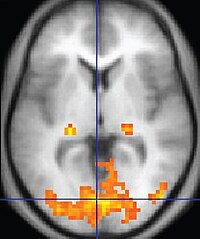
Photo from wikipedia
Abstract The lack of predictive biomarkers for therapeutic responses to schizophrenia leads clinical procedures to be decided without taking into account the subjects’ neuroanatomical features, a consideration, which could help… Click to show full abstract
Abstract The lack of predictive biomarkers for therapeutic responses to schizophrenia leads clinical procedures to be decided without taking into account the subjects’ neuroanatomical features, a consideration, which could help in identifying specific pharmacological treatments for the remission of symptoms. Magnetic resonance imaging (MRI) is a technique widely used for radiological diagnosis and produces 3-dimensional images in excellent anatomical detail, and with a great capacity to differentiate soft tissue. Various MRI techniques of the human brain have emerged as a result of research, enabling structural tests that may help to in consolidate previous findings and lead to the discovery of new patterns of abnormality in schizophrenia. A literature review was undertaken to assess the superior temporal gyrus (STG) as a possible biomarker in schizophrenia with the use of voxel-based morphometry of the brain using MRI. Many findings in studies of schizophrenia using MRI have been inconclusive and, in some cases, conflicting, although interesting results have been obtained when attempting to correlate neuroimaging changes with aspects of clinical features and prognosis of the disease. The individuals affected by this mental illness appear to have smaller STG volumes when compared to healthy controls and also to subjects with a diagnosis of first-episode affective psychosis or groups of individuals at high risk of psychosis. However, the wide variety of definitions surrounding the STG found in a number of studies is a contributing factor to the lack of correlation between brain abnormalities and clinical symptoms. For instance, disagreements have arisen due to studies using regions of interest to analyze the STG whereas other studies prioritize the analysis of only STG subregions or specific supratemporal plane regions. It is necessary to standardize the nomenclature of the areas to be studied in the future, as this will enable more consistent results, allowing higher clinical and morphological correlations.
Journal Title: CNS Spectrums
Year Published: 2020
Link to full text (if available)
Share on Social Media: Sign Up to like & get
recommendations!